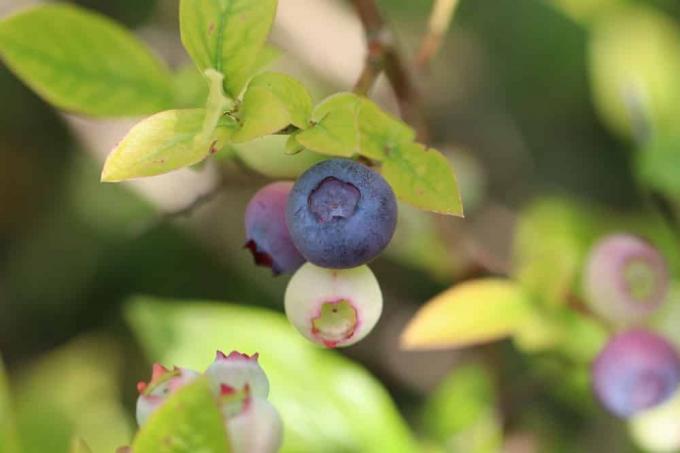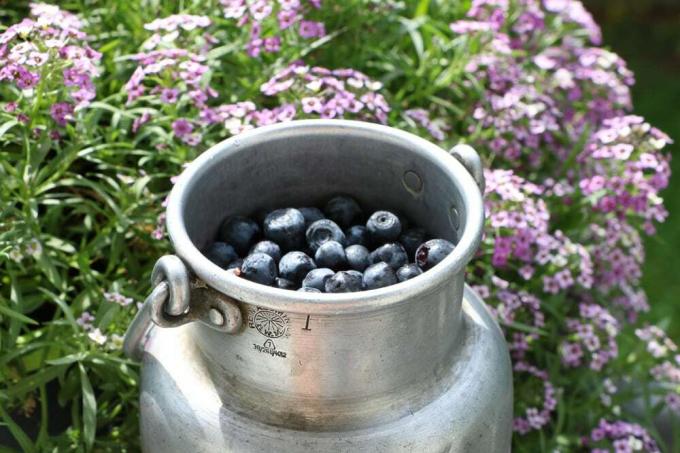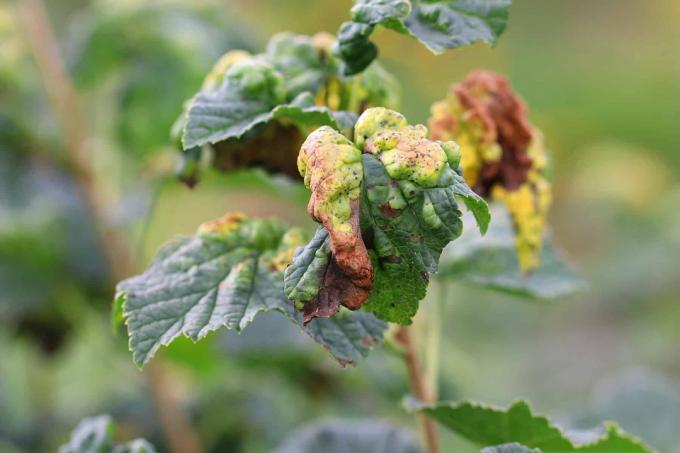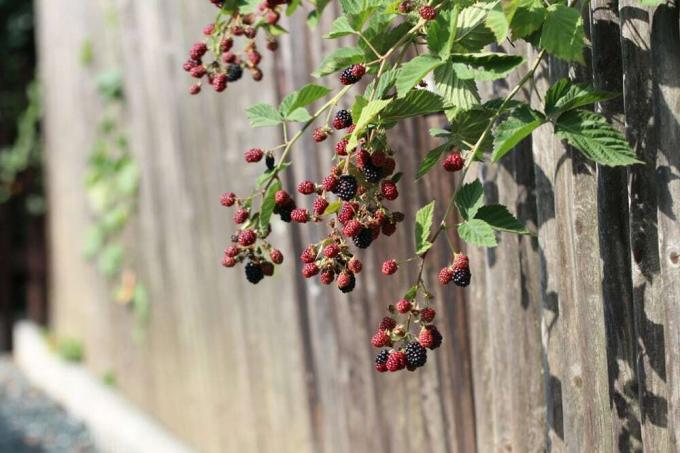

Table of contents
- Appropriate Varieties
- Location
- time
- Tool
- Preparation/ground conditions
- planting distance
- Plant
- transplant
- Conclusion
When you think of blueberries or blueberries, you usually think of the delicious blueberry muffins at the same time. But the delicious and healthy fruit is also very tasty and popular directly from the bush to the mouth. However, if you want to cultivate the fruit in your garden, you should definitely use cultivated blueberry varieties that should be planted in the local gardens. When is the best time for planting and how best to proceed is explained in detail in the following article.
Appropriate Varieties
Varieties that can be cultivated in local gardens are not descended from the native wild blueberry, Vaccinium myrtillus. This is a cross between the very tasty American blueberry Vaccinium corybosum and other species. This is how the varieties of cultivated blueberries came about, all of which are very tasty, juicy and fruity. The berries are a lot larger than those of the local wild blueberries and have light-colored flesh. The fruits also have more taste, but unfortunately also less vitamins and minerals. While wild blueberries usually grow herbaceous near the ground, cultivated blueberries are shrubs that often aim high. Good to cultivate are therefore, for example:
- Bluecrop from the USA
- Berkeley also bred in the USA
- Heerma, bred in Germany with origins in America
- Ama, also goes back to American varieties, bred in Germany
- Spartan, very hardy variety
- Elizabeth, late variety
- Liberty is said to guarantee a long harvest
- Hortblue Poppins has a particularly crunchy flesh
Since the blueberries are self-fertile, cross-pollination by another variety is also very good and respond with a larger yield, it makes sense to plant several different varieties in a garden bed. In addition, it can also be harvested over a longer period of time, since not all varieties bear their tasty berries at the same time.
Tip:
When buying cultivated blueberries, it makes more sense to use a somewhat more expensive but older plant, about four years old. This pays off, as the shrubs only produce a good harvest after about five to six years. This is much faster in the home garden with an older plant.
Location
In contrast to the native wild blueberries, which are usually found in the shady to semi-shady areas at the edge of the forest, the cultivated varieties like it rather sunny. But the ideal place should also be a little sheltered from the wind. The perfect location for a blueberry bed could look like this:
- a full sun garden bed in a corner of the garden
- a high fence or hedge provides sufficient wind protection
- in front of a sunny south-facing house wall
- a place in the shade reduces the crop yield
- the more sun, the more vitamins in the ripe fruit
Tip:
The wind-protected location is particularly important for the reason that the soil does not dry out too quickly in the wind. However, if you observe daily and water if necessary, you can also plant the blueberries in an unprotected place if no other bed is available.
time

The ideal time for planting the shrubs is either autumn or spring. Container goods can be planted in both seasons, while bare-root goods should generally be cultivated in the garden bed in autumn. Which shrubs are purchased here in the garden trade is always a question of cost, because container goods are usually a lot more expensive than the cheaper bare-rooted or balled goods. These must also be used immediately on the day of purchase, at the latest on the next day. Container goods, on the other hand, can also remain for several days if they are watered regularly. Otherwise, the following should be considered when choosing the ideal time:
- Don't wait too long to plant in the fall
- Plant should grow before the first frost
- therefore choose older plants for planting in the fall
- do not plant too early in spring when frost is still to be expected
- but before the first shoot
- an overcast day without sunshine and rain is ideal
Tip:
In the year of planting, especially when the shrubs are planted in spring, all flowers should be removed so that the berries can take root. If it forms flowers at the same time, it puts all its energy into the flower, and the plant could wither.
Tool
Since the soil usually has to be prepared before the shrubs are actually planted, a number of tools are also required, which should be provided in advance. Because the larger the garden bed in which the blueberries are planted, the more work the preparation entails. So the following tool is needed for preparing the soil as well as for planting:
- spade
- shovel
- wheelbarrow
- garden fork
- watering can
- alternatively hose connected to rainwater collection basin
Spades and shovels are needed to dig up and possibly dig up the earth. The soil can be wheeled away with the wheelbarrow provided if there is excess as only part of the substrate is intended to be used and mixed. The garden fork is well suited for lifting up compost and peat. Since it is not allowed to water with hard water, collected rainwater must be used, which can be taken from the rain barrel with the watering can. Advanced gardeners have a large rainwater catchment tank fitted with a hose.
Tip:
Please do not connect the garden hose for watering the blueberries to a municipal water supply. The water is often very calcareous, which can vary greatly from municipality to municipality. But the lime it contains is always harmful. If you don't have rainwater available, you should filter the tap water beforehand and pour it with a jug.
Preparation/ground conditions

Blueberries are classified in the same plant category as rhododendrons. Above all, this means that a calcareous soil is poison for the tasty berry plant. The soil at the site should be rather acidic with a pH between 3.5 and 4.5. If you don't know the soil conditions at the selected location, you can quickly determine this with a pH quick test from the well-stocked gardening trade. To get the desired acidic soil for the blueberries, you can proceed as follows:
- Dig up the soil throughout the garden bed
- up to 40 cm deep
- then fill in azalea or rhododendron soil
- alternatively mix garden soil with lots of peat and sand
- Fold in a little compost from spruce needles
- Sawdust from untreated wood
- composted tree bark and foliage
If the soil in the entire garden is usually very calcareous, then the garden bed must be filled with the prepared soil be additionally protected for the blueberries by creating a raised wall of garden soil around the bed becomes. This prevents the lime from the surrounding soil getting into the bed of the blueberries with the rainwater and being absorbed by the roots there.
Tip:
Increased lime content in the soil is indicated by plants with yellow leaves. The bushes no longer grow. Too much lime usually interferes with iron absorption by the roots.
planting distance
In contrast to the wild blueberries, the cultivated blueberries that are planted in the home garden require more space. When creating the bed for the high-growing shrubs, it is important to ensure that there is enough space between the plants later to be able to walk through and pick. In addition, the roots of the plants should not interfere with each other. The ideal planting distance looks like this:
- a distance of 2.5 meters between the individual rows
- place individual plants in the rows at a distance of about 1.5 meters
- a correspondingly large garden bed is required
- for several bushes of tasty berries
- if there is little space, only two plants can be cultivated
- so you don't have to do without the tasty berries
However, a single blueberry in the garden is not a good decision, because the shrubs do not like to stand alone. In addition, with at least two plants of different varieties, the crop yield is significantly higher due to cross-pollination.
Tip:
Blueberries are shallow-rooted, so the planting hole has to be dug more widely and not so much deeply.
Plant
When the right location has been found and the soil has been prepared here, the blueberries can be planted. For this purpose, the holes are slightly dug at the appropriate planting distance. The plants must not be planted with their roots too deep in the ground, so it makes more sense to dig the holes wide than too deep. Drainage can also be installed in each planting hole to prevent waterlogging. Since the blueberries do not tolerate lime, it is better to avoid stones or gravel as a drainage substrate. Pottery shards are a better choice in this case. These are laid out on the bottom of the planting hole before the shrubs are planted. The procedure is then as follows:
- Do not plant shrubs too deeply
- the roots also need oxygen above all
- Carefully and loosely fill in the prepared soil
- don't step down
- it is better to shake the shrub again so that the soil is evenly distributed
- water well with collected rainwater
- lay mulch around the plants
- so they are protected from possible frost
- Soil stays moist longer
Blueberries are heather plants that should not be planted too deep. Because they react very sensitively to this, it can happen that the roots die off because they don't get enough oxygen. Therefore, the shrubs should only be planted so deep that the root ball with the upper edge should protrude about one to two centimeters from the thrown up earth.
transplant

As a rule, the blueberries should be given their appropriate location right from the start. As a rule, the shrubs should not be transplanted. If this has to happen, for example because too much lime has accumulated in the soil, then you should pay attention to the following information:
- only possible up to an age of about four to five years
- if yields are already expected, do not replant
- To do this, carefully remove the plants from the soil
- remove all soil from the roots
- water well
- plant in new location with prepared soil
- carried out in spring, removing all flowers
If the shrubs are transplanted in the spring, then this means that no harvest can be expected this year is as the flowers must all be removed to allow the plant to focus on re-rooting can. It is therefore always advisable to plant the shrubs in a suitable location from the start.
Conclusion
It is not easy to cultivate the tasty blueberries or bilberries in your own garden. Already when planting and with the soil conditions as well as the location, many different things have to be taken into account. And several shrubs in a large bed also need a lot of space. But if you don't want to do without the delicious fruits in the garden, you can just put two individual shrubs in a corner with prepared soil. Here the subsequent care is not quite as extensive as in a large garden bed with many shrubs. Since blueberries are very productive, several delicious blueberry muffins can be baked from the harvest of a single bush. If blueberries or blueberries are planted in the right location and are well cared for, they can Plants can reach an age of up to thirty years, during which time they also produce good yields again and again bring.
 garden editorial
garden editorial I write about everything that interests me in my garden.
Learn more about soft fruit

Leaf diseases on currants: leaf fall disease & Co
Diseases on the leaves are not uncommon in currants. They are triggered by fungi, viruses or various pests settle in. Many problems can be remedied with simple home remedies. Proper care also helps to prevent many diseases.

10 good neighbors of raspberries | mixed culture
Raspberries should grow healthily for several years and bring us a rich harvest every time. Choosing a good neighborhood helps to achieve this goal. But with whom does the berry plant like to share the bed and with whom not?

Honeyberry, Lonicera kamtschatica: 12 tips on location & care
In the local latitudes, the robust honeyberry can be cultivated and propagated well, as it does not make great demands on the site conditions and care measures. If you pay attention to certain factors when planting and cutting, you can already harvest sweet fruits in spring.

Cultivated blueberries: 4 important location criteria
The blueberry offers delicious fruits and is a visually appealing tree. However, the cultural form of the blueberry differs greatly from the demands on its location compared to its wild relatives. In the right location, cultivated blueberries can yield several kilos.

Blackberry location: 4 important criteria
Blackberries are a popular sweet fruit that is easy to care for. With a suitable location, plant health is guaranteed and the yield can be increased. The right location depends on the type of variety, because not every blackberry is insensitive to low temperatures.

Fighting lice on currants | 8 home remedies to get rid of aphids
When the first leaves appear on the currants in spring, there are often aphids on the bushes. The small insects are hidden under the leaves and can quickly cause a lot of damage. Therefore, lice should be combated at an early stage, ideally with natural home remedies.
